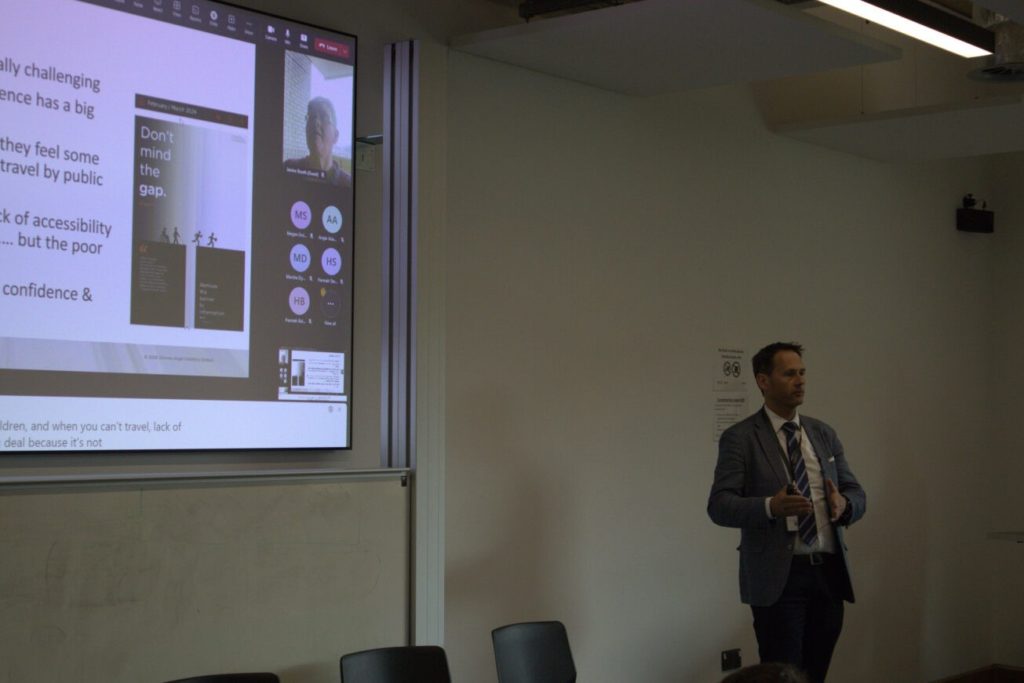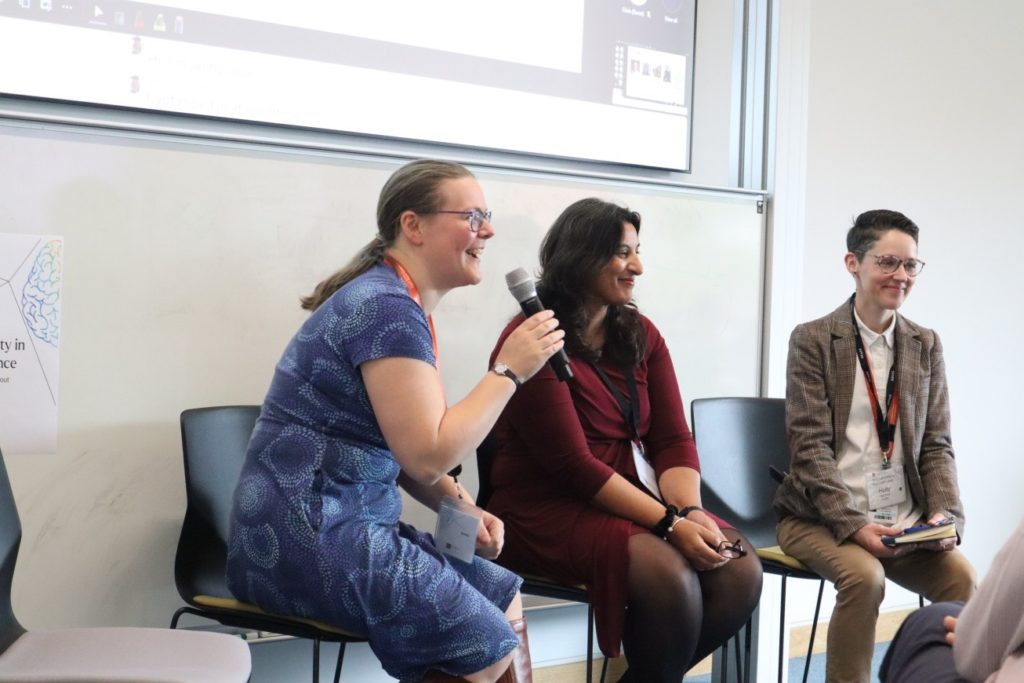Captured by Rajinder Pryor, MBE, Network rail and Women in Rail Trustee provided an overview of her takeaways and experience at the Neurodiversity in Rail Conference at the Birmingham Centre for Railway Research and Education (BCRRE).
Tuesday 21st May, held at Birmingham Centre for Railway Research and Education (BCRRE) University of Birmingham, was the much-awaited Neurodiversity in Rail Conference. The day was brimmed with insights and great discussion from cross-industry and international colleagues who gathered to learn more about this highly important issue, which isn’t widely recognised or understood. The conference boasted 72 different organisational representatives, each with their agenda, insights and knowledge.
Kickstarting was Paul Plummer, Professor in Rail Strategy, BCRRE, who welcomed everyone to the BCCRE established in 1971. He emphasised the bringing together of research and education in the railway – both feed off each other and into innovation. With a whole system approach and increasingly more of a human focus – embedding people across the piece is key.

Marika Taylor Programme Vice Chancellor, University of Birmingham added her own welcome, talking briefly about neurodiversity in STEM and the need to support those who are neurodiverse to thrive. She shared a map of neurodiversity by Amanda Kirby to help consider adverse events that may amplify challenges for some.

Dr Emma Langman-Maher from AECOM talked about her work-life experiences and challenges being diagnosed with both ADHD and autism.
How did nobody know? She described characteristics that showed her being different but assumed that as much of her family was similar, everyone else was ‘odd’!
In small groups, we were asked to: ‘Describe a railway station’… a simple exercise. Sharing our discussions, it was clear that our individual descriptions and understanding were different
Dr Emma talked about the link between engineering and psychology – psychology is essential within engineering to understand design for human beings.
Many people are high masking neurodivergent. So, is neurodivergence new?
George Stephenson was obsessive about detail and somewhat socially awkward. He had limited education, overcame substantial technical hurdles, and boasted many triumphs. Then there was Brunel, who too achieved much with broader interests as he didn’t focus on one thing. Both men are great examples of inspiring people to think out of the box – were they neurodiverse?
In terms of self-care and healthy coping mechanisms for Dr Emma, these included exercise and freely disclosing being neurodivergent as it takes less energy to be open. The experience of being diagnosed as a woman unfortunately takes much longer, and the process raises levels of anxiety in itself.
What others see as a small task seems impossible for me, but what is a challenge for others seems easy and doable for me.
Summing up, Emma finished with, “I have several disabilities; I have several talents.”
“You can’t know what you’re good at until you’ve tried several things and failed” – Zadie Smith.

Panel Discussion 1: Focusing on Passenger Experience
Mike Bradley, David Hitchcock, Lucy Cashin, Jesse Kailen, Kimberley Harding
Lucy Cashin shared the challenges of using trains from a disability and neurodiverse perspective. e.g., Not having the confidence to ask for a seat if you have a non-visible disability.

Mike Bradley discussed the development of a toolkit at the University of Cambridge to capture the needs of neurodivergent people. More research is needed to bake requirements into the design of trains etc. There are many reasons you can’t have things, but we need research to understand why it’s required in order to support change.
David Hitchcock remarked on Mike Bradley’s pioneering work and how we use it in the railway industry.
Mike Bradley commented on the demand a rail journey puts on people – hearing, sight and cognitive. It can be challenging for the brain to navigate an incredibly complicated journey – people without any cognitive impairment can struggle. People are excluded because of stress factors and cognitive challenges. We need to have opportunities to engage and understand factors and then design and mitigate them.
Jesse Kailen explored how we would do this if we made trains neurodiverse inclusive.
Quiet carriages with soft lights to influence passenger behaviour and de-stress. e.g. Buxton station is very inclusive.
Research has been done into understanding stress factors in passenger journeys – e.g. Crewe added a dedicated calm room. More stations are looking into using lighting and having a sensory space. Looking at the acoustic characteristics of spaces, can we reduce echoing? Cambridge is looking at research on lighting and mood.
Focus on training in neurodivergence across industry employees and raising awareness amongst passengers. Consider training for revenue employees and others.
It can be isolating when you are neurodivergent, as people don’t know how to treat you or communicate with you.
How do we include neurodiversity in technical standards? Turning people’s individual needs into something that can be specified. Things are vague and need to be looked at in more detail.
A startling reference was made to the number of Freight female drivers who have suffered from toxic shock syndrome. Although a separate study unrelated to the conference, Kimberley shared some additional research work she has done to encourage inclusive design practices in multimodal freight. Research has been into this to support female freight drivers led by Kimberley Harding, PHD Student. The fact that some women were taking medication or taking a week off to avoid menstruation at work seems difficult to comprehend.

Mark Robinson – Chrome Angel Solutions
If you can’t travel, the world shrinks – travel is needed for employment, socialising, education etc.
Mark talked to us about the Accessible Travel Simulation, which uses video game technology to develop an accessible travel virtual reality simulation. It is an immersive interactive learning experience that builds confidence and supports better access to travel. Benefits for passengers are providing better information, developing expertise and familiarity, setting expectations of support and service, reassuring and building confidence, and promoting awareness and empathy from staff and other passengers.

User group design workshops were held with people with various needs. Customer journeys were developed, and these were simulated.
A prototype developed which can be pushed out to mobile phones – built using technology – the player helps a chosen character on their journey: Where do I get a ticket? Who do I ask for help? It explores anxieties.
It is not surprising that the prototype has won multiple awards for customer experience.
It has been used to engage with communities that do not use trains and has been tested. Thanks to Angel Trains and Northern for their support.
An employee prototype is also being developed.
This is an experience and a game that people will want to play.
Robust data analytics can be used to research and understand user actions/choices.
Currently in testing and exploring funding. Watch this space!
An insightful keynote speaker from Janine Booth (Red in the spectrum), who offered training and shared 10 challenges for the industry to think about neurodiversity in the railway.
- Medical model v social model. Don’t just adopt the social model of disability – apply it!
- Awareness is not enough – need action for acceptance and inclusion.
- Reasonable adjustments for neurodivergent individuals are good but better to focus on change for everyone.
- Trained, available staff are crucial to accessibility for neurodivergent passengers.
- Use technology and innovation to work with staff – not to replace them.
- Complexity and competition create confusion. Make things simple.
- An inclusive railway for neurodivergent people is better for everyone.
- Neurodivergent workers’ rights do not depend on their productivity.
- Neurodivergent people are different from other people – and different from each other.
- Nothing about us without us. Keep people at the forefront.

Panel Discussion 2: Staff perspectives
Holly Foss, Director of Education, University of Birmingham, Rajinder Pryor MBE, Jenny Cooke
(A few points: I can’t speak and be a panelist!)
With audience participation, there will be a lively discussion about people’s experiences in the workplace.
Neurodiversity is still an area that needs greater awareness generally but also amongst South Asians – the journey for individuals is more complex due to lack of understanding within the community.
Cultural norms around mental health, differences, and inadequate language to discuss/educate are still in need of maturing across the industry and society. This hinders acceptance and looking for support.
Employers can support this by training managers and raising awareness. Not just putting policies in place but also making reasonable adjustments that allow individuals to thrive.
Empathy amongst colleagues recognising the differences of those around them goes a long way.
There is a lot to do in addressing the coping mechanisms for people who have never been diagnosed and how this impacts them in their careers and daily lives.

Steve Maslin, AtkinsRealis (Architect, Consultant, Speaker, Writer on inclusive design)
Another inspiring journey with Steve talks about his challenges and experience of being diagnosed with dyslexia. Achieving a first-class degree despite struggling to gain an English ‘O’ level after six times.
Inclusive design vs. Service design. Who are we designing for when we design – for everybody!
It’s essential to design inclusively and equitably. Value is achieved through a positive user experience.
What are some of the issues people face? Avoid situations. Attention struggles. Stress levels. Balance. Well-being. Orientation.
Things to aim for a sensory balance are calm and choice of auditory stimulus – choice but not confusing choice. HS2 quiet spaces technical paper produced with AtkinsRealis.
There are more people with neurodivergence at the railway, and we are not retaining neurodivergent staff. We need to increase awareness and have more discussion.
Ask what neurodiversity support people may need; Actively train people on what they need to know; Consider the training needs of neurodivergent line managers. Just be empathetic to others.
A cross-industry campaign is needed.

Professor Jon Elphick, Director, WSP summed up the day with reflections, closing remarks, and thanks to all the speakers and attendees.
Months of planning the event was made possible due to the sheer hard work of Kimberley Harding, a PHD Student studying Cognitive Ergonomics and Neuroinclusive Design implementations for UK Railways.
The day was filled with insights and thought-provoking conversations, lived experiences of challenges around understanding and living with neurodiversity.
We were taken back to the times of Stephenson and Brunel – what made these men so remarkable? Looking back, were they neurodiverse?
An award-winning Accessible Travel Simulation prototype – using video game technology to provide an interactive learning experience, supporting better access to travel.
Thoughts and ideas on how the industry can change – and must change to accommodate everyone.
10 Challenges for the industry to think about around neurodiversity in the railway.
Staff perspectives – highlighting real challenges and showing that there is still lots to do in the workplace. A different perspective and journey in living with neurodiversity with some insights into building design.
That’s a wrap!

A few special announcements:
The launch of the ‘Rail Industry Neuroinclusive Community (RINC) sponsored by the Women in Rail and Railway Industry Association Equality, Diversity, and Inclusion Charter.
Congratulations to:
- RINC Chair – Graham Candy, AtkinsRealis
- RINC Vice Chair – Sarah Holman, Network Rail.
The event was just the start! The conversations continue.

